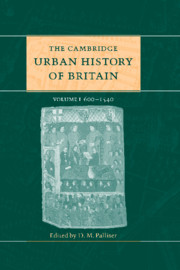Book contents
- Frontmatter
- Part I Introductory
- Part II The early middle ages 600–1300
- Part III The later middle ages 1300–1540
- Part IV Regional surveys
- 21 Regional introduction (England and Wales)
- 22(a) The South-East of England
- 23 Scotland
- Part V Conclusion
- Appendix: Ranking lists of English medieval towns
- Select bibliography
- Index
- References
23 - Scotland
from Part IV - Regional surveys
Published online by Cambridge University Press: 28 March 2008
- Frontmatter
- Part I Introductory
- Part II The early middle ages 600–1300
- Part III The later middle ages 1300–1540
- Part IV Regional surveys
- 21 Regional introduction (England and Wales)
- 22(a) The South-East of England
- 23 Scotland
- Part V Conclusion
- Appendix: Ranking lists of English medieval towns
- Select bibliography
- Index
- References
Summary
geographical and geological setting
The history of urbanisation in Scotland is predetermined by the geography and geology of northern Britain. Often assumed to be a country of sharp divide between Highland and Lowland, its physical nature, however, is more complex. It was not merely the mountainous areas of the Highlands that were seemingly unapproachable from the more gentle Lowland terrain; but the south-west regions of Galloway and Ayrshire were equally divorced from the east coast; and the southern border region of the country, in its very lack of natural, physical definition, often had a somewhat different agenda from the other parts of Scotland.
Even a cursory glance at the west coast of northern Britain, from Lancashire to the northern Highlands of Scotland, reveals the linkages that were to dominate this seaboard. Travel by water was to form the easiest method of contact for the western Highlands, Islands, Galloway and Ayrshire; and the predominant communication points and influences for these areas were to be not the Lowland basin centred around the River Forth, but Ireland and the North of England.
The east coast, by contrast, used the sea to look to mainland Europe, and in particular northern France, the Low Countries, Scandinavia and the Baltic. They were more approachable, in terms of both ease and time of travelling, than the less accessible parts of Scotland. Rivers, such as the Tweed, the Forth, the Tay and the Dee, all providing natural harbours, would become the foci for this contact. Perth and Stirling, at the highest navigable points of the Rivers Tay and Forth respectively, were to play crucial roles in Scotland's history; and Berwick, Dundee and Aberdeen, with their good harbourage, were to dominate the economic scene; but increasingly under the hegemony of Edinburgh through its pre-eminent port of Leith.
- Type
- Chapter
- Information
- The Cambridge Urban History of Britain , pp. 715 - 738Publisher: Cambridge University PressPrint publication year: 2000
References
- 1
- Cited by

